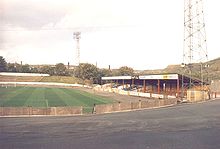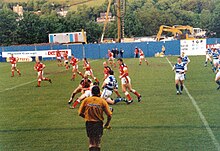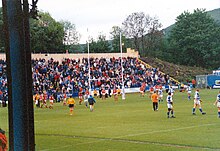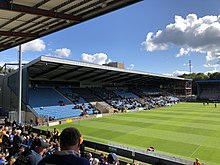The Shay
Rugby LeagueHalifax Panthers (1998–present)Huddersfield Giants (2011 – 3 games) The Shay is a multi-purpose sports stadium in Halifax, West Yorkshire, England.
[citation needed] At the time of the third year of Henry VIII's reign (this means either 1511 or 1512), the Subsidy Roll (effectively the equivalent of our present income tax) had recorded William Brodley junior as being assessed on goods to the value of £20, and by 1545 the property was still in his possession.
[citation needed] This may seem a small sum today but it is worth noting that only five people locally were assessed at £20 (including the wealthy Vicar Haldesworth who was once robbed of £1,000), so it is fair to say that William Brodley was a man of influence and money.
Just when William Brodley died is not clear but we do know that the Shay descended to his daughter and heiress Grace Hely in 1580,[citation needed] and in turn to her husband John Booth in 1587.
[citation needed] John Caygill provided the land and £840 for the construction of the Piece Hall, a monument which still stands today as a tourist attraction.
[citation needed] John Caygill junior's only child, the aforementioned 'Jenny', became sole heiress to her father's estates, including the Shay.
It is clear that the Ibbetson family did not live at the Shay - they did not need to, and so in the Halifax Journal of 18 April 1807, the mansion built by John Caygill was advertised for letting.
It was the idea of John Booth to develop the pleasant Caygill's Walk, which ran along the top of the Shay, into what is now the busy Skircoat Road.
This dramatic period in the Shay's history continued when, two years later, on 29 August 1891, Skircoat Road was opened for traffic for the first time.
Even then, there was some criticism of the idea, but the board of Halifax Town made an official approach to the Shay's owners, the Corporation, and it was accepted.
At a public meeting on 9 July 1920, the then Halifax Town chairman Dr A.H. Muir stated: "Speaking from inside information I know that if, in February 1921, we can produce a ground that will meet league requirements, and if we can show financial backing that is worthy of a town this size, our position as members of the English League with all that means, is absolutely secure.
"[citation needed] In that same speech Dr. Muir announced that the Town directors were to meet members of the Corporation's Improvements Committee with a view to the leasing of the Shay, so that they could prepare it in time for the 1921-22 season.
On Wednesday 4 August 1920, a recommendation was put to the committee which was passed and the Halifax Courier set up a fund to help get the Shay ready.
Fans, players and directors worked together to get the ground ready, and on 7 December the first grass sods were laid on the playing pitch.
[citation needed] In March 1921, Halifax Town were elected to the Football League, and along with clubs such as Accrington Stanley, Ashington, Durham City and Nelson, became founder members of the newly formed Division Three North.
[citation needed] The capacity stood at 16,500 until 1985 at which time the Popplewell Report into ground safety was released following the Valley Parade disaster in May of that year.
When Halifax Town were paired up with Nottingham Forest in the FA Cup in January 1988, in an effort to keep the tie at the Shay, more work was carried out and the capacity was raised further to 4,021.
[citation needed] The other, involving the development of a sports complex, including a ground for the club, was turned down because of difficulties over the conditions demanded by the Edinburgh property firm behind the move.
[citation needed] The situation became so serious that Halifax Town manager Mick Jones resigned for a more secure position at Peterborough United.
On 23 December, John Madeley announced he had signed an agreement with a property company which, he said, would safeguard soccer at the Shay until the end of the season.
[citation needed] They were prepared to put money into the club, but wanted to move it out of the Shay so they could develop it after the season's close.
[citation needed] On 4 March 1987, councillor Geoffrey Butler put forward a plan to split the Shay – one half as a soccer ground with the other to be developed.
Though many people in Halifax were not too bothered about the club's plight, soccer fans cried out to the council to make a positive move.
On 10 November 1951 speedway promoter Bruce Booth brought midget car racing to the Shay to boost funds.
"[4] In November 1962, Middlesbrough speedway promoter Reg Fearman saw the Shay for the first time, and in 1963 he made a formal application to Halifax Town for use of the ground to revive the sport.
By the 1970s people valued it greater than football for family entertainment, with the Dukes producing such renowned riders as Eric Boocock and Kenny Carter.
The brand new East Stand, conference facilities and car park at Halifax's Shay Stadium place the venue back at the heart of Calderdale's sporting and community life.
There are 11 function rooms, ranging in size to accommodate every type of event, from one-to-one interviews to larger conferences, weddings and meetings for up to 350 guests.
The leader of the project was Lee Ashforth who drove the company forwards and set up a committee based on 4 directors who previously had been involved with the Shay Stadium Trust.
[citation needed] The plan was to build a two-tier stand with shops that backed onto Skircoat Road, however nothing has been officially announced.






